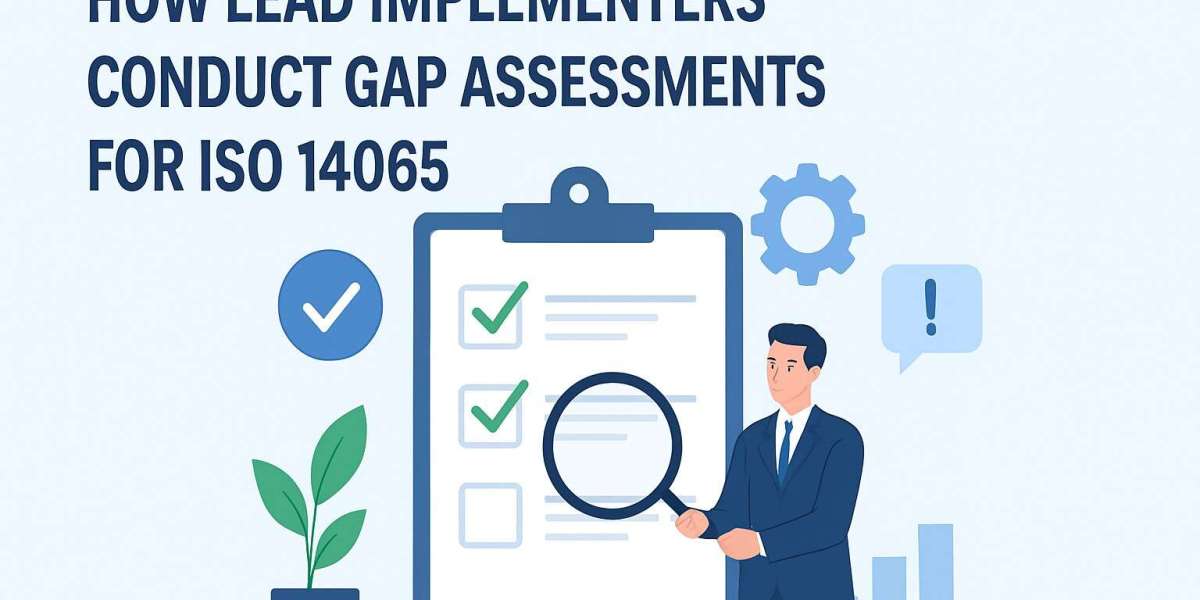The growing emphasis on climate change, sustainability, and greenhouse gas (GHG) verification has made compliance with internationally recognized standards more critical than ever. Among these standards, ISO 14065 holds a unique place. It specifies the requirements for bodies that validate and verify environmental information, ensuring consistency, transparency, and credibility in climate-related disclosures. For organizations aspiring to achieve compliance, the role of the Lead Implementer is indispensable. One of their primary responsibilities is conducting a gap assessment, which helps identify where the organization stands compared to ISO 14065 requirements and what needs to be improved.
In this article, we will explore the process, significance, and best practices for conducting a gap assessment for ISO 14065 by a Lead Implementer.
Understanding Gap Assessment in ISO 14065 Context
A gap assessment is essentially a diagnostic exercise. It compares an organization’s current practices, systems, and documentation against the specific requirements of ISO 14065. The outcome highlights the “gaps” that prevent the organization from achieving conformity.
For a Lead Implementer trained in ISO 14065, this assessment is not merely a checklist activity. It requires in-depth knowledge of the standard, analytical skills to evaluate organizational practices, and leadership qualities to communicate findings effectively.
Steps Lead Implementers Follow for ISO 14065 Gap Assessments
- Preparation and Planning
Before diving into the assessment, the Lead Implementer prepares a detailed plan. This involves:
- Understanding the organization’s scope of activities (e.g., GHG validation, verification of sustainability reports, or emissions inventories).
- Reviewing existing certifications, policies, and documentation.
- Establishing timelines, team responsibilities, and communication channels.
A well-prepared plan ensures that the gap assessment is structured and efficient.
- Review of ISO 14065 Requirements
ISO 14065 covers specific clauses related to impartiality, competence, consistent processes, and transparency in validation and verification. A Lead Implementer reviews each requirement and creates a framework to evaluate how well the organization currently meets it.
For example:
- Competence: Are verification personnel qualified and trained?
- Impartiality: Are there safeguards against conflicts of interest?
- Consistent Procedures: Does the organization follow standardized methodologies?
This mapping ensures no requirement is overlooked.
- Data Collection and Interviews
The Lead Implementer gathers evidence from various sources. This may include:
- Documentation reviews (policies, manuals, past verification reports).
- Interviews with management and technical staff.
- Observation of current practices and workflows.
The goal is to obtain both qualitative and quantitative information to measure alignment with ISO 14065.
- Gap Identification
After data collection, the Lead Implementer highlights areas where the organization falls short. Gaps may include:
- Missing or incomplete documentation.
- Lack of staff training in GHG verification techniques.
- Weak internal controls for ensuring impartiality.
- Insufficient procedures for handling client complaints.
Each gap is documented with clear references to the relevant ISO 14065 clause. This precision helps management understand the criticality of each issue.
- Risk and Impact Evaluation
Not all gaps carry the same weight. Some may be minor documentation errors, while others may undermine the credibility of the entire verification process. Lead Implementers classify gaps based on risk and impact, allowing organizations to prioritize corrective actions.
For instance, a gap in impartiality safeguards would be considered high risk, as it directly affects the integrity of the verification body.
- Action Planning
Once gaps are identified, the Lead Implementer works with the organization to create a corrective action plan. This includes:
- Specific steps to address each gap.
- Assigning responsibilities.
- Setting realistic timelines.
- Identifying resources and training needs.
This plan becomes the roadmap toward ISO 14065 compliance.
- Reporting and Communication
The findings are documented in a structured report, which typically includes:
- An executive summary.
- Detailed gap analysis results.
- Risk prioritization.
- Recommended corrective actions.
Effective communication is critical. The Lead Implementer ensures that the report is presented in a clear, actionable format so that top management can make informed decisions.
Importance of Gap Assessments in ISO 14065 Implementation
Conducting a gap assessment is not just about preparing for certification. It adds value in several ways:
- Clarity and Direction: It provides a clear picture of the current status versus required compliance.
- Risk Mitigation: By identifying gaps early, organizations can avoid costly nonconformities during certification audits.
- Efficiency: Resources are allocated more effectively when organizations know which areas need urgent attention.
- Confidence: Stakeholders, including clients and regulators, gain confidence when they see that compliance is managed systematically.
Best Practices for Lead Implementers
- Stay Updated: Regularly review updates in ISO standards and environmental regulations.
- Engage Stakeholders: Involve employees across all levels to ensure accurate assessment.
- Use Tools and Checklists: Structured tools improve consistency and minimize oversight.
- Focus on Continuous Improvement: Treat the gap assessment not as a one-time activity but as part of a cycle of improvement.
Conclusion
A gap assessment for ISO 14065 is a crucial step in aligning organizational practices with international standards for environmental validation and verification. Lead Implementers, with their specialized training, play a pivotal role in guiding organizations through this process. By systematically identifying shortcomings, evaluating risks, and creating action plans, they help organizations not only achieve compliance but also enhance credibility, transparency, and trust in their environmental reporting.
In today’s world, where sustainability and climate accountability are at the forefront, the expertise of ISO 14065 Lead Implementers in conducting thorough gap assessments ensures that organizations are well-prepared to meet global expectations.



